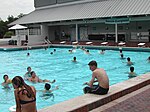Coconut Grove Playhouse

The Coconut Grove Playhouse was a theatre in the Coconut Grove neighborhood of Miami, Florida, United States. The building was originally constructed as a movie theater called the Player's State Theater. It opened on January 3, 1927, as a part of the Paramount chain. The movie house was designed by the architect Richard Kiehnel of Kiehnel and Elliott. It was built by local realtors Irving J. Thomas and Fin L. Pierce. Albert Peacock was the contractor. The theater was renowned as the second movie theatre on the east coast of Florida to be air conditioned and having the largest Wurlitzer organ in the United States. It was used for a variety of shows until closing in 2006. It has not been used since. It was listed on the National Register of Historic Places in 2018.
Excerpt from the Wikipedia article Coconut Grove Playhouse (License: CC BY-SA 3.0, Authors, Images).Coconut Grove Playhouse
Main Highway, Miami
Geographical coordinates (GPS) Address Nearby Places Show on map
Geographical coordinates (GPS)
| Latitude | Longitude |
|---|---|
| N 25.7255 ° | E -80.244731 ° |
Address
Main Highway 3516
33133 Miami
Florida, United States
Open on Google Maps









